Vive la Revolution! Giles and Sue are about to experience the 10 most tumultuous years in French history - 1785 to 1795.
It was also the age of discovery with the arrival of electricity and hot air balloons (more on that later).
Our Supersizers will be living as King Louis XVI and Queen Marie Antoinette in Vaux-le-Vicomte, the alleged inspiration for the Palace of Versailles. Their chef for the week is Mickael Weiss, head chef at the Coq D'Argent or as I like to call it The Money Chicken and which hilariously has the address of One Poultry.
Michael's kitchen or l'office de la bouche is stuffed with supplies as gluttony is very much the order of the day, although 90% of the French population at the time lived on bread and soup.
No white bread for them though - it was thought that aristocrats could only digest the finest, fluffiest white bread whilst the peasants were only allowed the coarsest brown. Michael's preparing only dishes from Massialot's Cuisinier Roial et Bourgeois.
First up is the King's Breakfast: Lamb Cutlets; Roast Capon; Westphalian Ham; Eggs in Orange Flower Water; Champagne.
Orange flower water was the perfume of Versailles - they loved it so much they scrambled eggs with it. Giles emulates Louis XVI by eating like "a monkey in a zoo" and belching loudly so Sue is driven to suffocate him with a ham.
5,000 combined calories later, the pair wander off to relieve themselves in the corner - Versailles was a stinking swampland with little plumbing; it was cleaned only once a year and that took two weeks.
After a short etiquette lesson in gliding gracefully, it's time for dinner where the entire court had to stand and watch the King and Queen eat before they could join in.
Le Grand Couvert
1st Service: Frog's Leg Soup; Cucumber Soup; Mussel Soup; Melon Soup; Partidge in Bechamel Sauce; Roast Chicken; A Tower of Eggs.
Chef Mickael is surprised to see frogs on the menu as this was usually a commoner's dish. He's preparing them three ways - with verjus, in a ragout of mushrooms, and deep-fried in batter all served in the same tureen. Sue likes it but keeps thinking about decapitated boinging frog. Also the melon soup tastes of BO.
2nd Service: Roast Mutton; Roast Beef with Garlic Sauce; Chicory Salad; Artichoke Salad; Orange and Pomegranate Salad.
The mutton has been stuffed with ham and truffles and covered in breadcrumbs; it sounds rather nice but apparently tastes like lamb MDF. Sue's quite keen on the languostine swords though.
Giles wants more wine but etiquette dictates that he must wait for the pourer, the server and the taster who take about 7 minutes to get him a cup.
So that the court wouldn't get bored watching and waiting, Louis would entertain them by playing Egging the Egg - perching a softboiled egg on top of a wine bottle and then slicing the top off with the swing of a knife. Giles proves rather less than adept at this party game.
The piece de resistance of the meal was the royal jelly - roast beef and diced vegetables and sweetcorn suspended in molten calves feet.
In truth, it was designed to be looked at rather than eaten.
Marie Antoinette in fact hated eating at all in front of an audience and would often leave early, whilst Louis continued to gorge himself on pasties until he was so often sick that his wife eventually banned them.
When eventually they both took to their bed, Louis's eating would continue as he'd often have a midnight snack of game pie delivered - this may be why they didn't consummate their marriage for seven years.
It's 1785, Louis XVI and Marie Antoinette now have three children and Marie Antoinette has introduced such new-fangled notions as weekly bathing and flush toilets and plumbing, this in an age when so many died in bath after consuming heavy meals that many avoided bathing altogether.
Sue's trying Marie Antoinette's favourite bath filled with asses' milk, blanched almonds, linseed, pine nuts, lemon peel, rose petals, marshmallow and lily bulbs. She bathed twice a week but such was her modesty that she did so fully clothed.
Marie Antoinette often liked to nibble in bath - Sue has a croissant, that most iconically French pastry and reveals that it was in fact Austrian in origin - the Viennese kipferl made to commemorate a victory over Turks as the crescent represented the Turkish flag.
Electricity had just been introduced from America and Marie Antoinette liked to pass electric currents through her body as health treatments. One of these Tesla-esque contraptions still exists so Sue takes the plunge - her wig unfurls wildly and blue sparks fly from her fingers - it's like X-Men or something.
Sue yells at Giles for "inserting [his] anus into [her] forcefield" when he tries to fart blue lightning at her. However, this move backfires (boom boom) as it shocks him too.
After all this excitement, Giles and Sue go home for a private dinner a deux - roast meats and game for him, and broth and biscuits dipped in water for her.
King's Supper: Soupe Royale; Calves and Pigs Feet; Rabbits in Love; Roast Pork with Maille Mustard; Crepes with Chantilly Cream; Madeira.
Queen's Supper: Bouillon de la Reine; Cold Roast Fowl; Dunking Biscuits; Lemonade.
The Soupe Royale is a kind of bouillabaisse, with chunks of eel flesh, pike's liver, and bright orange cod roe in thick broth.
The Rabbits in Love have been stuffed, rolled and roasted and then placed facing one another on a platter of lettuce. One of their toothy heads rips off when Giles picks it up. Delightful.
1789 is the Year of Revolution - famine has caused riots to rage across the land. Marie Antoinette is oblivious however as she visits her play farm at the bottom of the garden at Versailles.
Sue re-enacts this pastoral fantasy, but all the egg-gathering tires her out so she has tea with some friends.
There's apfel strudel from her home, orange-flower, rosewater and lemon meringues, macarons, jellied fruits, and candied violets, all made with that most expensive import of all, sugar. Peasants wouldn't even recognise this as food - just as ornamentation.
Sue tries on the legendary Breast Cup - porcelain specially commissioned in the shape of Marie Antoinette's bosom as a symbol of fertility and nourishment.
And did Marie Antoinette really say "Let them eat cake"? It's highly unlikely, since these words were first spoken by a princess in a story by Rousseau which was published when Marie Antoinette was only ten.
Meanwhile Giles is investigating the Saviour of France - the potato. Grain is scarce, yet the people refuse to eat the pomme de terre as it's only fit for pigswill and is rumoured to cause leprosy. But potato evangelist Antoine-Augustin Parmentier has created a visionary banquet to convince them otherwise.
Potato Banquet: Creamed Potato Soup; Potato Salad; Pomme de Poisson; Parmentier Bread; Potato Pudding Pudding; Potato Vodka.
It fails miserably.
It's the eve of the Revolution and like Marie Antoinette and Louis XVI before them, Sue and Giles are holding one last private dinner, but beforehand they must make themselves pretty.
The aristocracy's reliance on powder, perfume and rouge was seen as a sign of a nation in decay.
Beauty historian Elisabeth De Feydeau helps Sue and Giles primp and preen and cover themselves in fake blue veins (blue blood) and beauty spots and for Sue, an enormous wig or pouf.
This pouf is reflected in the first course of Creme du Barry made from cauliflower florets (to resemble the wig), chicken stock and cream.
Also on the menu is poached salmon with langoustine served on a bed of newly invented mayonnaise - created in honour of the French naval victory over the British at Mahon.
Next come a cavalcade of dishes designed by Carême and recognisable as French haute cuisine today such as Duck a l'Orange, Mushroom-stuffed Sole Fillets, Crayfish in Champagne, and a delicious-looking Millefeuille of Foie Gras with Truffles (I think Giles is wrong, I swear a millefeuille should have pastry - this is more of a terrine).

Last it's the desserts, with Marie Antoinette's favourites Chantilly Cake; Rhum Baba (I used to adore this as a kid but haven't seen them in years - where can I get one now?), and little custard pies called Wells of Love.
Chef Michael brings out one more surprise in the form of a sugar recreation of the Bastille alight with sparklers.
The Bastille prison, the symbol of the king's absolute power, was stormed and burnt to the ground by revolutionaries on 14 July 1789. A few months later on 13 October 1789, Versailles was also stormed and the King and Queen put under house arrest.
It's 1791, Louis XVI and Marie-Antoinette have had enough and disguised as peasants try to escape. They had so much baggage their carriage had a maximum speed of 7 mph. Giles and Sue are also fleeing with the same packed lunch that the king and queen took with them.
Escape Dinner: Boeuf a la Mode; Carrots in Aspic; Petis Pois a la Francaise; Champagne.
Aspic was invented for this very meal - Marie Antoinette loved her carrots so her chef created a way of stopping them flying around.
Sadly this Great Escape came to an untimely end when the king was recognised from a coin (this made me laugh out loud) - they were recaptured halfway to the Austrian border. The government was now led by Robespierre and at his order the King was beheaded on 21 June 1793.
Marie Antoinette was left to languish in a tiny cell where she was intimidated and given no privacy. Her last supper was a simple soup yet she only managed a few drops before she also succumbed to the guillotine's blade on 16 October 1793.
In honour of her stoicism, the great chef Carême recreated this last meal of hers, but added vermicelli to give her strength and vitality (though this seems a bit like shutting the stable door after the horse has bolted).
In total, 60,000 people killed in the Reign of Terror. Those loyal to the revolution had to wear red, white and blue to symbolise the Tricolore, the new flag of France. Even food and ways of eating changed to reflect the new regime.
Republican Feast: Pain D'Egalite; Pigeon Bisque; French Fries; Sans-Culottes Cake; Chestnuts; Red Wine.
Pain d'Egalite or Equality Bread was made of half white and half wholemeal flour - thus throwing out the old bread divide. It was also rock-hard which was unfortunate as it was made to be shared. Cutlery was now frowned upon, as is etiquette and absolutely everything had to be shared.
Giles and Sue can't handle the pigeon, but are delighted at the innovation of French Fries - the potato is the food of the new Republic. They share their picnic in the Place de la Concorde, the site of the guillotine, where women would knit as they watched the decapitations, and Madame Tussauds began making waxworks of the more prominent victims.
In 1794, Robespierre himself was sent to the guillotine - the Terror was finally over. The last remnants of aristocracy came out of hiding and decided to honour their fallen brethren by dressing in a macabre fashion - ladies wore short, jagged haircuts and guillotine shaped earrings and the executioner's cross adorned their backs and men tied red ribbons around the necks to symbolise the fall of the blade.
When Sue ties Giles' ribbon, they look at each other with such love and affection, it's no wonder some people ship them.
These new aristocrats also roamed the streets to seek retribution, attacking anyone they thought Republican (ie peasants).
So many people were killed in this new White Terror that more died than in the Reign of Terror itself.
On a happier note, the restaurant was invented at this time - named after the invigorating, restoring broths that they served. Food was finally democratised - your wealth, not your class determined what type of bread you ate.
The world's first restaurant critic also appeared at this time - Grimod de La Reynière, who held judging panels for the food of these new restaurants and brought out the first restaurant guides, and whose own dark sense of humour saw him hosting macabre feasts where food was served on coffins and pigs were guests of honour.
Giles decides to hold a banquet in honour of the man who invented his job. And yes, a pig is invited.
Macabre Dinner: Turtle Soup; Black Bread; Caviar; Monstrous Egg; Mule Steaks; Frankfurt Sausages; Roast Venison in Chocolate Sauce; Truffles in Jelly; Seventeen (you heard me) Coffees.
The soup is actually Mock Turtle - Squid with Oxtail - and palatable enough.
But the Monstrous Egg comprises forty eggs boiled in a pig's bladder; and the guests recoil at both the rotten smell and the sight of the bladder birthing the eggs one by one Aliens-style.
Chef Mickael says it's the most disgusting meal he's ever created, but to me it looks morbidly wonderful and it seems a fitting way to end this week of Revolutionary excess.
And now that the fun is all over, Giles and Sue visit the doctor to check how they've been affected by their diets. Astonishingly they're both fitter than they were at the start of this exercise - cholesterol down, livers in peak condition.
It's woefully ironic that after a week of living as historically-renowned gluttons Louis XVI and Marie-Antoinette, they're both in fact in better nick than usual...
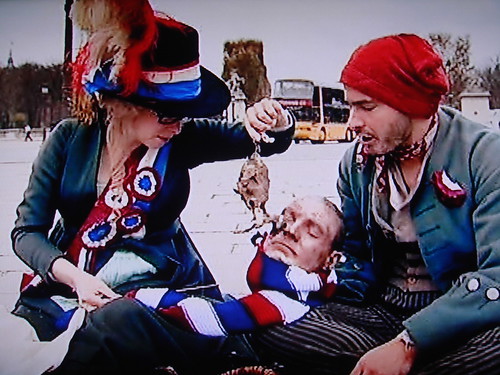
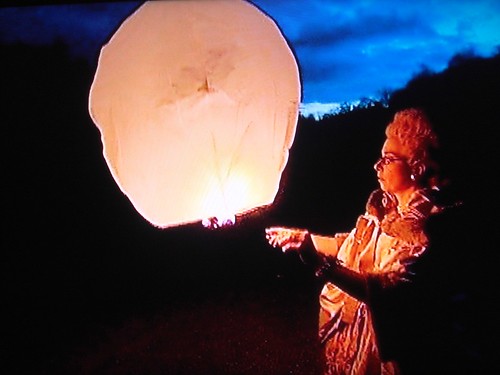
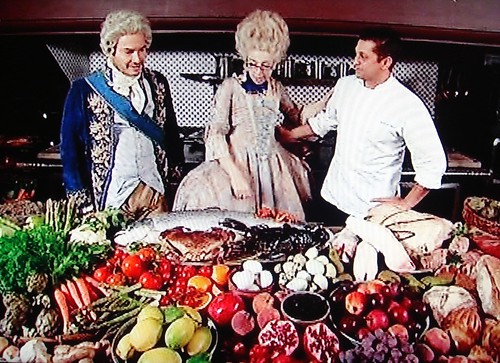

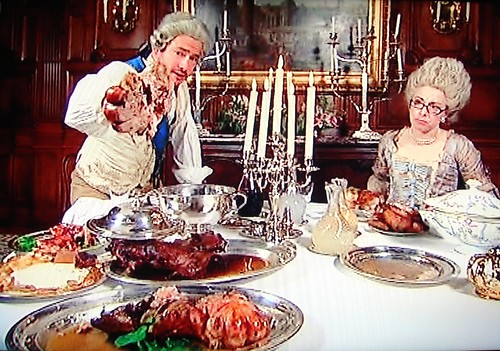
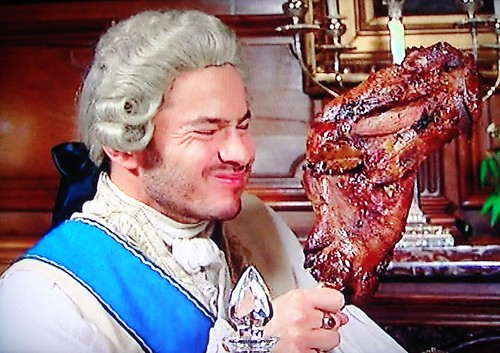
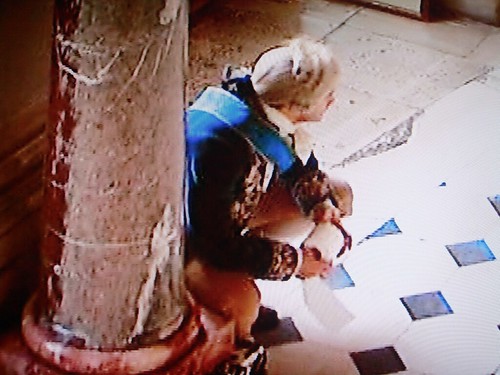
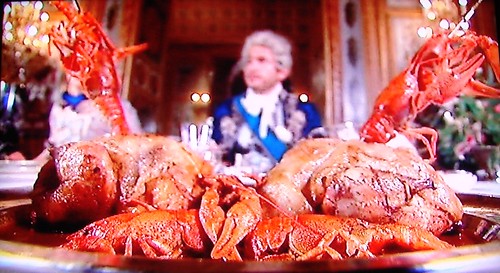
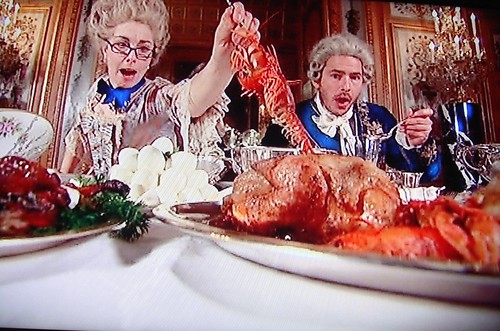
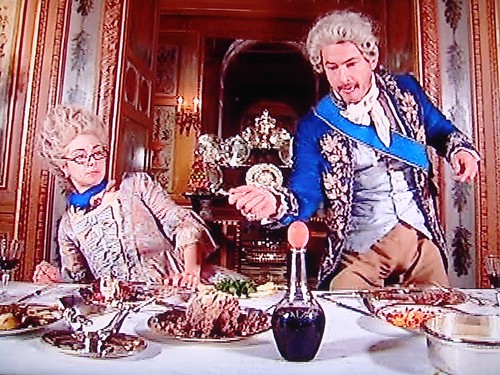

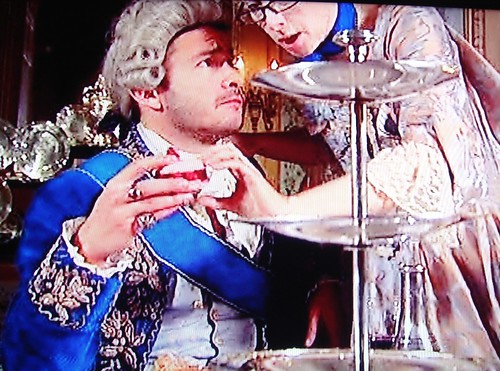

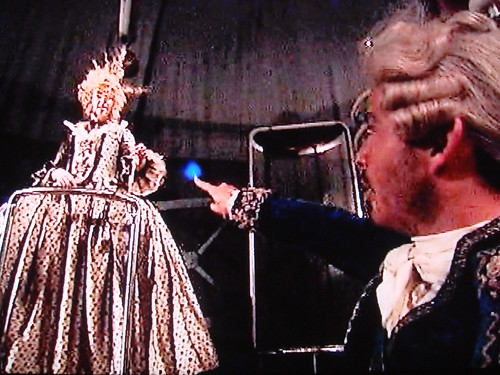
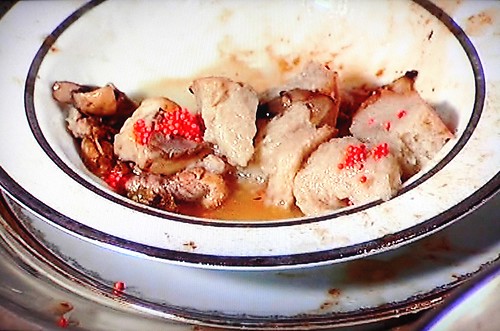
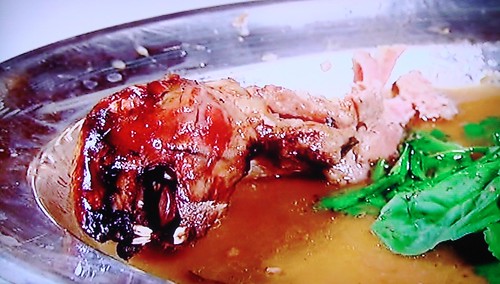
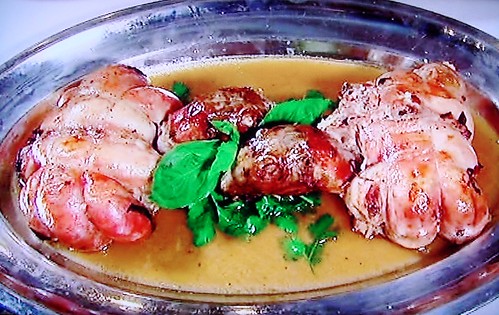


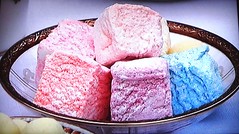

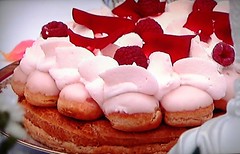
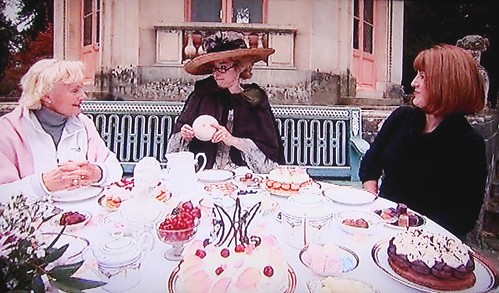
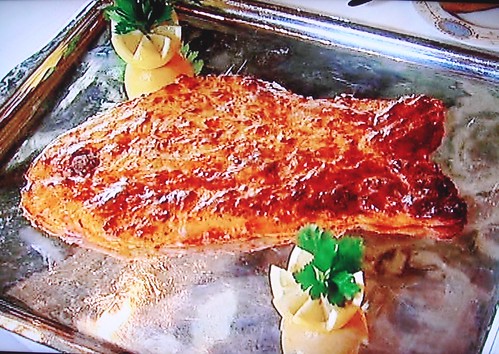

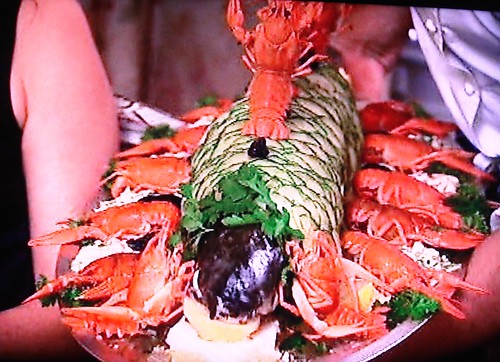
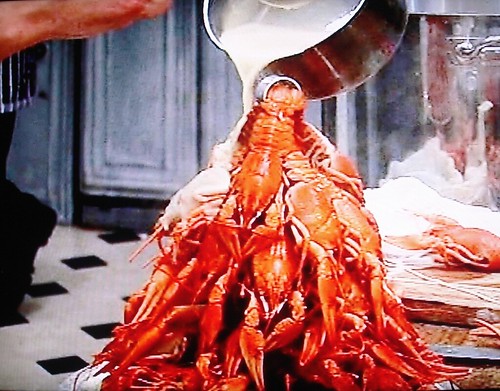
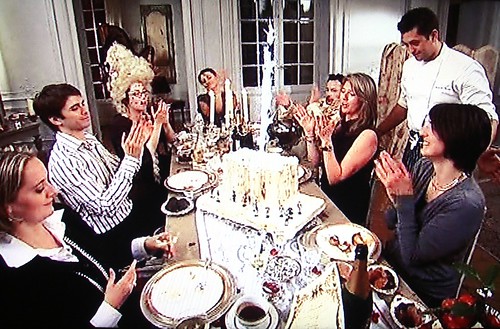
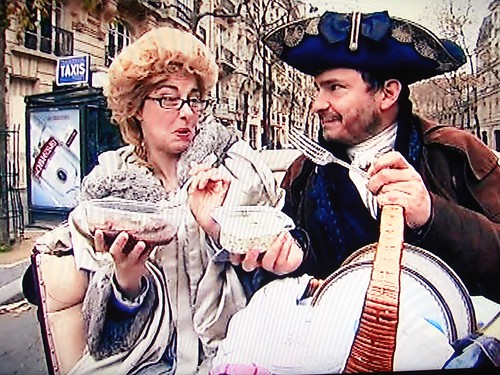
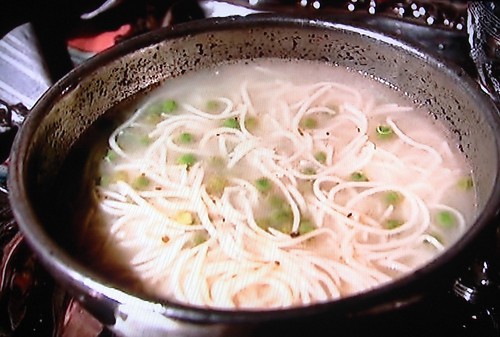
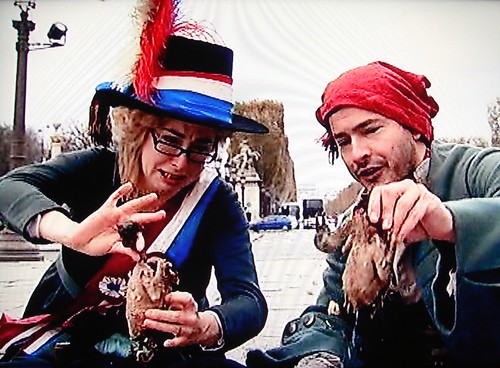
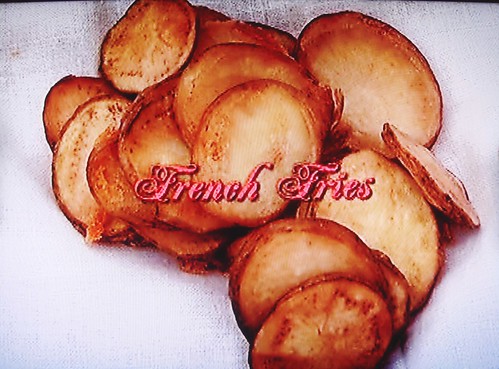
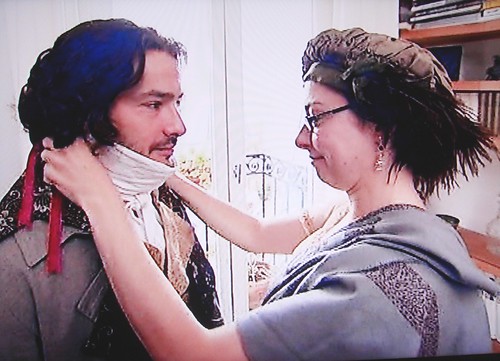
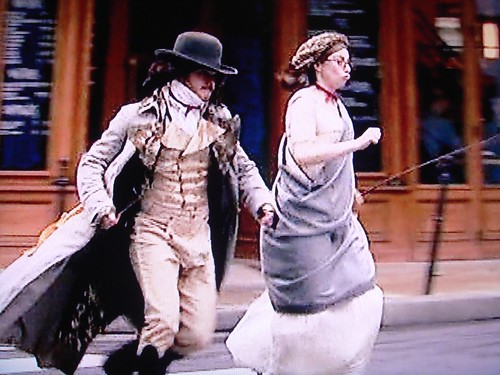
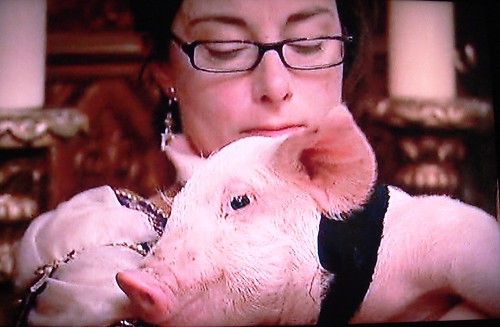
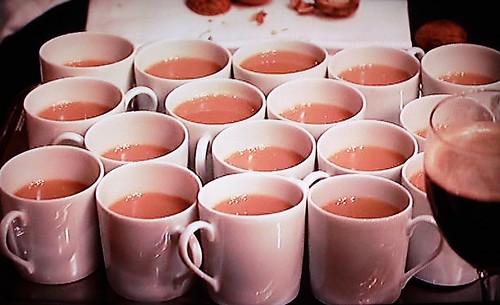
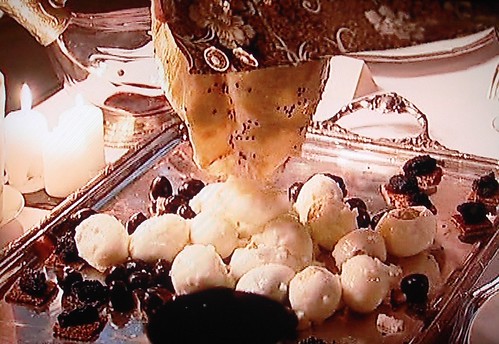
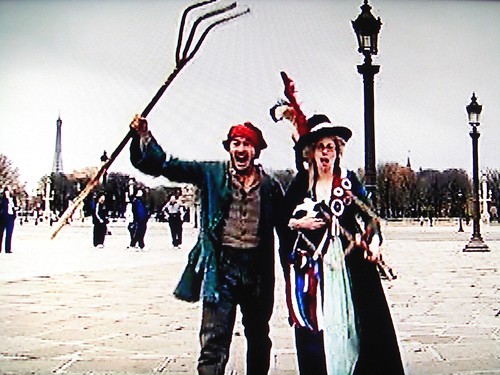
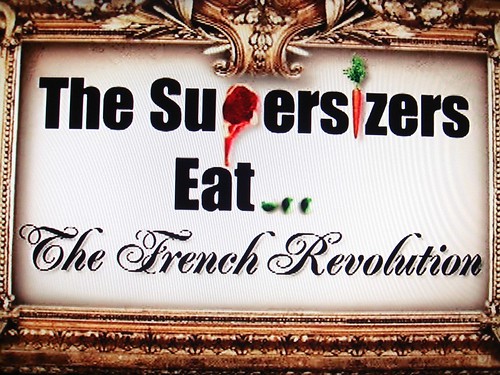
Comments